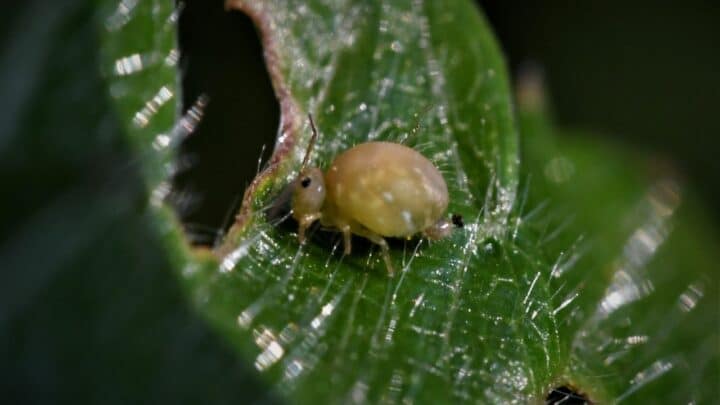Springtails. No, they are not birds, but microorganisms that fertilize the soil naturally.
While many people may attempt to get rid of springtails, especially when they take up residence in a person’s home, some people actually breed and culture springtails, as these micro-organisms can be beneficial to a garden.
So, if you decide to breed and culture springtails, what do you feed them? Since springtails have vast appetites, there are many items that they will eat.
Fortunately, there is no need for special springtail food. Most likely, you already have items in your pantry that your Springtails will be more than happy to eat.
What Do Springtails Eat?
Springtails eat many everyday items, including yeast, fish food, rice, cucumber peels, and crushed dry macaroni. Naturally, springtails thrive on eating algae, bacteria, and vegetation that is beginning to decay, so it is no surprise that springtails will often refuse to eat an actual food item, but rather munch on mold that is growing on the item.
Springtails Will Eat Many Food Items from Your Pantry
Springtails seem to enjoy eating brewer’s yeast and dry rice. However, it’s advisable to allow the rice to develop mold which will attract the springtails.
They will eat both brown and white rice, so it doesn’t matter which kind of rice you feed them.
Now, they may eventually start to lose interest in the food provided for them. This doesn’t mean that you need to change your springtail’s diet, but you should simply replace the food dish with a fresh palette.
Yeast is the main pantry item that springtails love, but you don’t need to feed them a diet of yeast only. Instead, you can just sprinkle the brewer’s yeast over the other items in their food dish.
Springtails will also enjoy the dry oats that have been sitting in the back of your pantry, and some people who culture Springtails insist that crushed macaroni is amongst the food items that Springtails will eat, which makes sense given that they seem to enjoy rice and yeast.
Any type of dry pasta will probably suffice in the event that you don’t have macaroni or rice.
Additionally, fish food and flakes are eaten by springtails, but some experts advise against feeding them fish food, while others stand by their decision and claim that salmon pellets are thoroughly enjoyed by springtails.
Cucumber peels are another good item to give to springtails, but since they seem to like eating mold, you could likely improvise with any fruit or vegetable that is starting to decay.
If the pieces of fruit in the basket on your dining room table are beginning to go bad, you can feed the fruit to your Springtails instead of tossing it in the garbage.
The same goes with regards to the moldy tomato on the bottom of your refrigerator. If it starts to spoil, the chances are good that your springtails will eat it.
Springtails Eat Fungi, Bacteria, Algae, and Rotten Vegetation
Sure, you may be thinking that this sounds completely gross, but this is part of the reason that springtails are so good at fertilizing soil.
If you have dead plants in your garden, the springtails will feed on them and eventually eliminate the plants, which can aid in cleaning up the environment.
Springtails are even known to devour dead worms, as some Springtail species are carnivorous, and may even feed on each other.
While it is doubtful that you will harvest dead worms for your springtails, once these microorganisms are left to their own devices to handle the task of fertilizing your garden, they may very well take on the job of eliminating many insects and pests.
Basically, springtails have the ability to seek out their own food and feed themselves.
They don’t truly need a bowl of food placed out for them daily as though they were a pet dog or cat, but those who decide to breed and culture Springtails will often choose to provide these microorganisms with their initial meals, while some people consider offering additional food to Springtails to be a token of appreciation as these microorganisms can do wonders for a garden.
But bacteria? Fungi? Algae? It’s unlikely that you will keep those items on hand, except for the unwanted growth on top of spoiled food items.
However, your strawberry field or tomato garden may indeed produce fruits and vegetables that are tainted by bacteria, fungi, and mold. Springtail’s duty is to handle this issue for you and maintain the health of your plants.
Frequently Asked Questions about What Springtails Eat
How Often Do You Feed Springtails?
Springtails can be fed with a simple dash of yeast every few days. Since they have the capacity to seek out their own natural food sources, it is unnecessary to feed springtails frequently.
What Do Springtails Need to Survive?
Springtails require a moist environment for their survival. Naturally, they live under leaves and deep within the soil that is moist. They feed upon dead insects, algae, bacteria, fungi, and decaying plant life when left in their natural environment.
Conclusion
Basically, springtails naturally feed upon decaying plant matter, bacteria, fungi, and algae. When they are left in their natural habits, they can definitely seek out their food sources on their own.
While you probably don’t want a springtail infestation in your home, they can be very beneficial to your garden.
When breeding and culturing springtails, they will eat several basic items from your pantry, including rice, oats, and yeast.
Springtails aren’t difficult to feed, and once they are placed outside, they will surely repay you by fertilizing the plant life in your yard.


